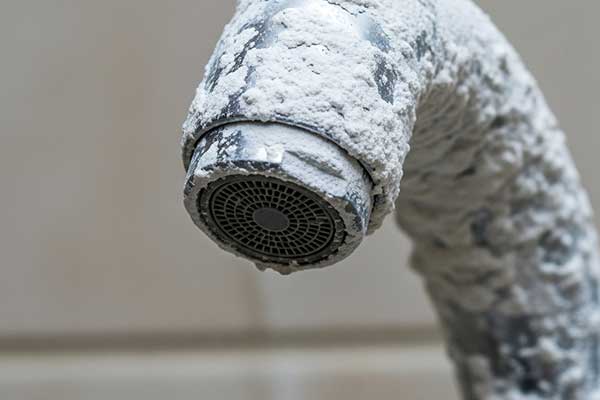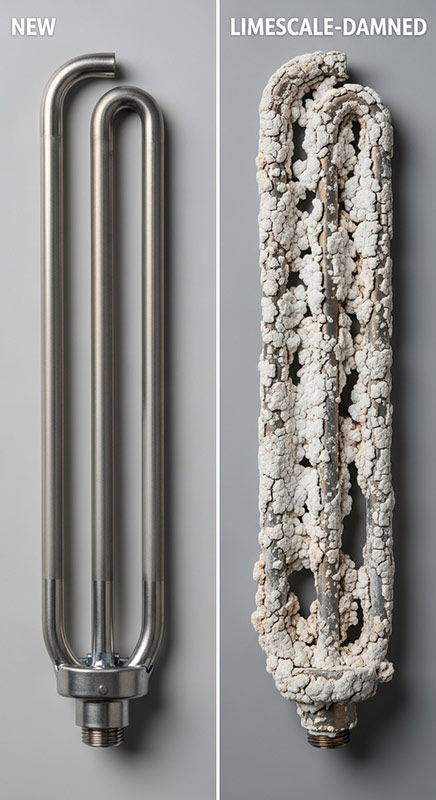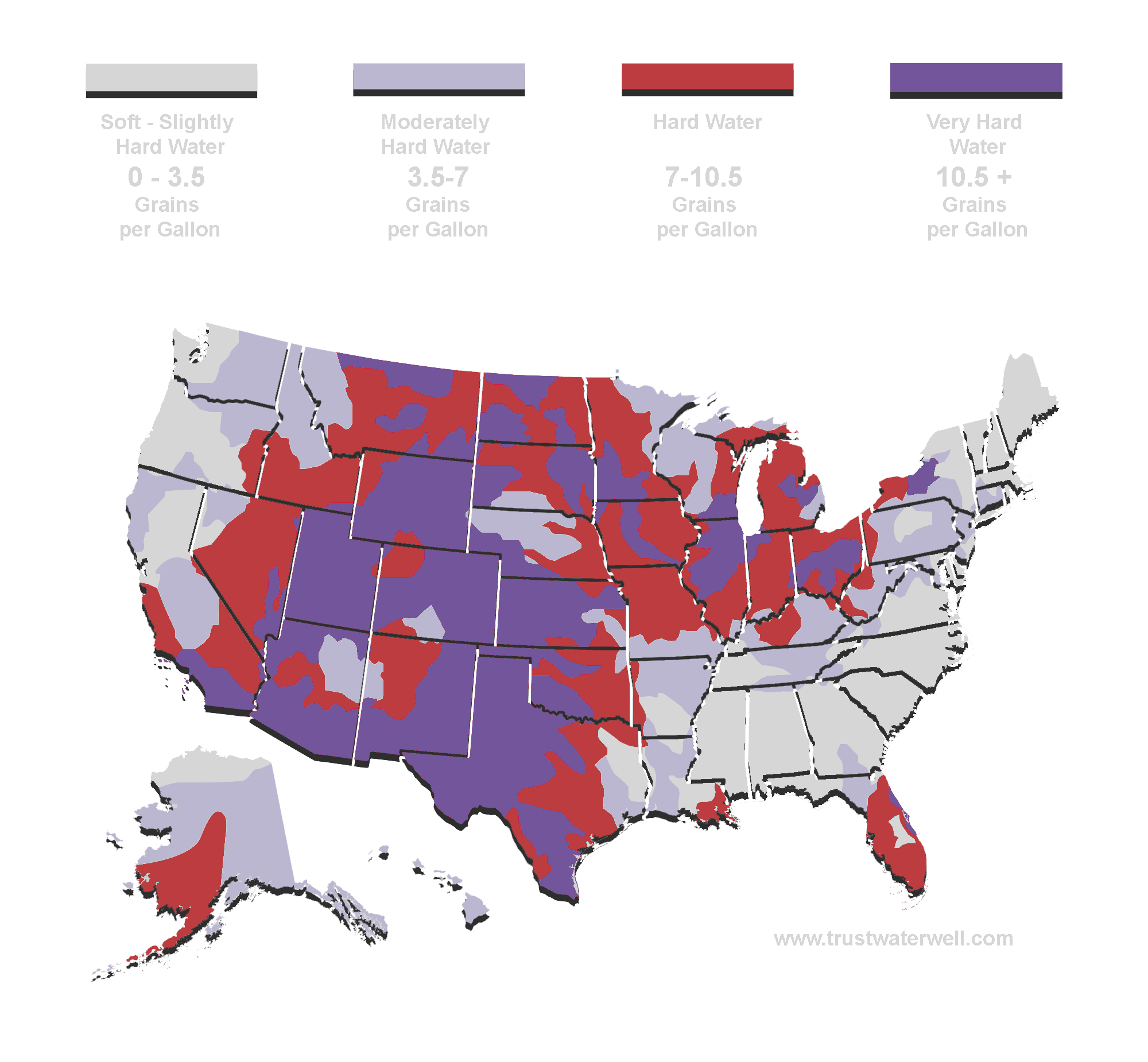What is Hard Water? A Complete Guide to Signs, Causes, and Damage
I never thought about water. It was just… there. It came out of the tap, filled my glass, washed my clothes. It was the most predictable, most invisible part of my life. Until the day it wasn’t.
It started with my skin. After every shower, I’d feel this strange, tight sensation, as if my skin was a size too small. I blamed new soaps, dry winter air, getting older—anything but the water itself. Then came the endless scrubbing. A stubborn, chalky film coated our glass shower door. Our dishes, fresh from the dishwasher, looked cloudy and sad. My wife, who loves her bright white linens, complained they were turning a dingy gray.
The breaking point was a small, silly thing. We had friends over for dinner, and I proudly served coffee in our best glass mugs. As I handed one to our guest, I saw it—a constellation of white spots clinging to the inside. No matter how much we washed them, they never looked truly clean. I felt a wave of embarrassment. Here I was, trying to create a perfect evening, and my own water was betraying me.
That night, after our friends left, I looked inside our electric kettle. The heating element at the bottom was caked in a thick, rocky, off-white crust. It looked like something you’d see in a cave, not a kitchen appliance. That’s when it hit me: the tight skin, the gray laundry, the spotted glasses, the crust in the kettle—they were all symptoms of the same disease. Our house had a problem, an invisible enemy flowing through its veins, and I didn’t even know its name.
“I thought this was my personal problem—a strange quirk of our home’s plumbing. I felt isolated by it until I saw a map that changed everything. Hard water isn’t an exception in this country; for most, it’s the rule. According to data from the U.S. Geological Survey (USGS), over 85% of American households have to deal with hard water. That means my story is very likely your story, too.”
What’s Really in Your Water? The Science Behind the «Clay Mask»
That tight, filmy feeling on my skin after a shower? I used to call it “squeaky clean.” I later learned it was the exact opposite. It was a layer of soap scum—a residue created when soap reacts with the minerals in hard water. It was like rinsing with liquid rock and leaving a fine layer of a clay mask on my entire body.
So, What Is Hard Water Scientifically?
In simple terms, hard water is water with a high concentration of dissolved minerals, specifically calcium (Ca²⁺) and magnesium (Mg²⁺). Rainwater is naturally soft, but as it travels through the ground, it seeps through layers of rock like limestone, chalk, and gypsum, picking up these mineral particles along the way. By the time this water reaches your tap, it’s carrying these invisible hitchhikers.
How is it Measured?
Water hardness is measured in two common units:
- GPG (Grains Per Gallon): The U.S. industry standard.
- PPM (Parts Per Million): Equivalent to mg/L, used in lab results.
The conversion is simple: 1 GPG = 17.1 PPM.
The Water Quality Association (WQA) Hardness Scale
| Hardness Level | Grains Per Gallon (GPG) | Parts Per Million (PPM) | What It Means For You |
|---|---|---|---|
| Soft | Less than 1.0 | Less than 17.1 | Ideal. Soap lathers easily, no mineral buildup. |
| Slightly Hard | 1.0 – 3.5 | 17.1 – 60 | Minor effects, perhaps some light spotting. |
| Moderately Hard | 3.5 – 7.0 | 60 – 120 | Problems become noticeable. Scaling begins. |
| Hard | 7.0 – 10.5 | 120 – 180 | Significant limescale buildup. Damage to appliances begins. |
| Very Hard | Over 10.5 | Over 180 | Severe scaling and plumbing issues are likely. |
A Crucial Distinction: Is Soft Water the Same as Pure Water?
It’s easy to fall into a common trap and believe that once you’ve installed a water softener, your water is now “pure.” This is one of the most important misconceptions I have to clear up.
A water softener is a highly specialized tool. Its job is to perform one critical task with surgical precision: to remove the hardness minerals, calcium and magnesium. It excels at this. It stops the formation of that hard, crusty limescale that acts like cement.
However, it does not significantly reduce the Total Dissolved Solids (TDS) in your water. Your water still contains other dissolved minerals and salts. So if your home’s water has a naturally high TDS level (over 500 PPM, for example), you might still notice a faint, white, powdery residue after a drop of softened water dries.
But here is the critical difference, and I want you to remember this:
Limescale from Hard Water
The “Cement”
It sticks, builds up layer by layer, and requires acids or harsh scrubbing to remove.
Residue from Soft Water
The “Dust”
It doesn’t stick or build up. It wipes away effortlessly with a simple damp cloth.
Seeing this faint, dusty residue doesn’t mean your softener failed. It means it worked perfectly. It prevented the “cement” from ever forming. This distinction is the line between water softening and water purification—a topic for another day.
The 7 Telltale Signs I Learned to Recognize
After that incident with the kettle, I became a detective in my own house, determined to understand what is hard water and the damage it causes. Once you know what you’re looking for, the evidence is everywhere. These are the seven main clues I now spot instantly in my clients’ homes, time and time again.
1. Soap Scum & Residue
That sticky, white film on your shower walls, tubs, and sinks? That’s soap scum. The fatty acids in soap bind with calcium and magnesium ions, creating an insoluble mess that refuses to rinse away.
2. Spotted Dishes
If your glasses emerge from the dishwasher looking cloudy or polka-dotted, hard water is the culprit. As the water evaporates, it leaves behind mineral deposits (calcium carbonate).
3. Dry Skin & Dull Hair
Hard water can be brutal. Mineral deposits clog pores and disrupt your skin’s pH balance, causing dryness and irritation. It also weighs hair down, leaving it limp and frizzy.
4. Stiff, Faded Laundry
Minerals trap dirt in fabric, leading to a stiff texture and causing colors to fade and whites to turn a dingy yellow or gray. You’ll also use far more detergent to get a lather.
5. Limescale Buildup
That chalky, crusty white substance colonizing your faucets, showerheads, and coffee maker is limescale. It’s a sign that the same buildup is happening where you can’t see it.
6. Reduced Water Pressure
If your shower feels more like a weak drizzle, limescale could be the cause. Over time, these mineral deposits build up inside your pipes, gradually choking your home’s water pressure.
7. Inefficient and Failing Appliances
This is the most expensive sign of all. The heating elements in your water heater, dishwasher, and washing machine are prime targets for limescale. This mineral crust acts as an insulator, forcing the appliance to work much harder and use more energy, leading to higher bills and a shortened appliance lifespan.

The Journey of a Raindrop: Why Your Zip Code Matters
Why does one town have liquid rock for water while another enjoys naturally soft water? The answer lies in geology. The hardness of your water is determined by its journey from the sky to your tap.
Rainwater starts as soft water. But as it falls and filters through the earth into underground aquifers, it passes through layers of rock and sediment. If you live in a region rich in limestone or gypsum, the water will dissolve high amounts of calcium and magnesium. Ancient seabeds that once covered large parts of the United States left behind dense mineral concentrations, resulting in notoriously hard water in those areas.
This geological process is well-documented by scientific bodies. According to the U.S. Geological Survey (USGS), the primary factor determining water hardness is the presence of carbonate rocks. This is why the question of **what is hard water** often has a different answer depending on your state’s geology.
U.S. Water Hardness Map by State
Vast areas of the country, including the Southwest, Midwest, and Florida, deal with some of the hardest water, with cities like Indianapolis, Las Vegas, and Phoenix having GPG levels of 15 or higher.
Disclaimer: Please note that this map provides a generalized overview of water hardness across the United States. Actual hardness levels can vary significantly by region, city, and even neighborhood. For the most accurate information, we recommend checking the latest Water Quality Report from your local water utility or using an at-home water test kit.
What It’s Really Costing You—And You Don’t Even Know It
I used to think hard water was just an annoyance. I was wrong. It was an invisible tax on my home and my wallet. The mineral buildup quietly damages your most expensive investments.

-
Skyrocketing Energy Bills
A study by the Water Quality Association found that water heaters using hard water consumed nearly 26% more energy. Research has also shown that just 1.6mm (about 1/16th of an inch) of scale can reduce efficiency by 12%. -
Premature Appliance Death
Hard water is a killer of appliances. It shortens the lifespan of water heaters, dishwashers, washing machines, and coffee makers by clogging pipes and valves and burning out heating elements. -
Costly Plumbing Repairs
The same limescale you see on your faucet is building up inside your pipes. Over years, this can lead to major clogs, low water pressure, and eventually, the need for expensive repiping work. -
Wasted Cleaning Supplies
Hard water reduces the effectiveness of soaps, shampoos, and detergents. You end up using 30-50% more product just to get a decent lather, which means you’re literally pouring money down the drain.
The Showdown: Hard Water vs. Soft Water
Understanding the enemy is half the battle. Seeing the difference side-by-side makes the benefits of treatment crystal clear.
| Feature | Hard Water | Soft Water |
|---|---|---|
| Lathering | Poor. Soap reacts with minerals to create scum. | Rich, luxurious lather with minimal soap. |
| Skin & Hair | Leaves skin feeling dry and itchy; hair is dull and limp. | Skin feels smooth and clean; hair is soft and manageable. |
| Laundry | Clothes feel stiff, colors fade, whites turn gray. | Fabrics are softer, colors stay vibrant, whites remain white. |
| Dishes | Leaves white spots and cloudy film on glassware. | Spotless, crystal-clear dishes and glasses. |
| Plumbing | Causes limescale buildup (scaling) in pipes and fixtures. | No mineral buildup, protecting pipes and fixtures. |
| Appliances | Reduces efficiency and shortens the lifespan of water heaters, etc. | Maximizes appliance efficiency and extends their working life. |
| Cleaning | Requires more soap and effort to clean up soap scum and scale. | Cleaning is faster and easier, with no scum or scale to remove. |
| Mineral Content | High in calcium and magnesium. | Very low mineral content (calcium/magnesium removed). |
Questions I Always Hear
As I’ve shared my story, people always ask the same questions. Here are the quick answers to the most common ones.
In the simplest terms, hard water is water that contains a high amount of dissolved minerals, primarily calcium and magnesium. It’s created when rainwater passes through rock like limestone and chalk, picking up these minerals before it reaches your tap.
Hard water leaves behind mineral deposits that can clog pores and strip your skin of its natural oils. This disrupts the skin’s pH balance, making it feel dry, tight, and itchy, and can worsen conditions like eczema or dermatitis for some people. (For a full breakdown, visit my article on [How Hard Water Impacts Your Skin and Hair]).
The easiest way is with an at-home test kit. You can use simple DIY test strips or, for more accurate results, a titration kit that measures the exact hardness level in GPG or PPM. (I walk through both methods in detail here: [How to Test for Water Hardness]).
What I Did Next — And What You Must Do Too
My discovery started with a simple glance inside my kettle. It was the first step on a long journey. But to truly solve a problem, you have to understand its magnitude. A simple “suspicion” that you have hard water isn’t enough. You need precise data. You need to know your number.
Are you dealing with 5 GPG of moderately hard water, or are you in the 15 GPG “very hard” zone like parts of Arizona and Indiana? The answer determines everything that comes next. It dictates the type of solution you need and the urgency of the problem.
Guessing is gambling with the health of your home. Testing is the first step toward taking back control.
My journey to healthier skin and cleaner water began with an embarrassing discovery. But that frustration led me to knowledge—knowledge that I want to share with you, so your path can be shorter and simpler.
You’ve already taken the most important step: you are no longer in the dark.

